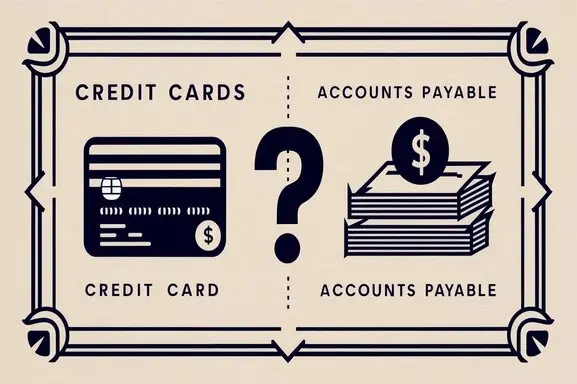Are Credit Cards Considered Accounts Payable?

From the above understanding, it can be deduced that accounts payable do not necessarily equate to credit cards.
In any organization, there is normally more than one account they deal with, for instance, accounts receivables, and accounts payable among others. Hang on a second though, do credit cards apply to accounts payable? That is why it is high time to turn to the examination of the phenomenon more thoroughly.
What are Accounts Payable?
Accounts payable can be defined as money that a business owes its suppliers or merchants who provide goods and services on credit.
Common examples of accounts payable include:
- Accounts payable aging, which refers to the amount of time it takes to pay suppliers or vendors for services rendered or products supplied
- Accounts such as accounts payable for services received but not paid, rent, salaries to employees, etc.
- The short-term loans and the long-term loans
- Interest on loans overdue
Technically, if you have incurred expenses or made purchases on credit and have not yet paid for the same then such a case falls under the category of accounts payable. It is classified under the current liabilities of the balance sheet.
For example: As you receive the invoices from the vendors, they would increase the accounts payable balance. And as you incur those invoices, that balance goes up, and when you clear those invoices, it’s brought down again. The objective is to minimize the accounts payable which will enable the business to pay off its suppliers on time to uphold good business relations.
Are credit cards classified under accounts payable?
Well, this leads us to the next question: how do credit cards integrate themselves into the accounts payable formula? The fact is that credit cards are rather an exception. For instance, whenever you decide to buy something using your credit card, it means that you assume an obligation to the credit card company for a short-term period, and thus it is a liability. However, credit cards are not usually reported under the account payable line of balance.
Instead, credit card balances fall under their category:
- Credit Cards – This is a total current liability figure that is tracked as a separate line item.
There are a few reasons why credit cards get their category:
1. Easier Tracking: One advantage of having credit cards separate is that it simplifies how monthly credit card statements and payments can be prepared. Unlike the amount owed, which is often grouped with vendor invoices, credit card balances are separate and easy to identify.
2. Personal vs Business Expenses: At the very least, with vendor invoices, you are sure that those can only be business expenses. But for some accounts, employees can make both personal and business charges on company cards hence the need for special attention before payment is made.
3. Faster Payment Terms: With a credit card balance, you have to clear the amount in full by the end of the month while you have 30 to 60 days to clear vendor invoices. Because this timeline is faster, it needs to be measured separately.
4. Interest & Fees: Credit card companies charge interest and some special fees for every balance you roll over from the previous month. While it can be a bit messy, it is administratively more efficient to keep that separate from normal accounts payable.
Best Practices
As for saving time for your accounting department to sort out the expenses made by corporate credit cards, it is advisable to set measures of the proper and improper usage of such credit cards. Things like:
- The extent of allowable purchase jenis jenis pembelian yang diperkenankan
- Spending limits
- Expense report procedures
- Transaction structures (pay in full, reimburse employees, etc)
You should also have a clear procedure for checking the statements and receipts once in a while every month in an attempt to find out if there is any unauthorized expenditure.
Reward programs credit cards are associated with employee cards, cash back, points, or even miles that can be of advantage to your business. But ensure your team knows the proper use of it or it becomes the opposite as everyone starts misusing it.
Also, holding credit card balances long term results in expensive interest charges and this simply reduces one’s profit margin. Practical rules will need to be set down regarding payments so that balances can be paid off monthly.
Accounting Treatment
Here is a high-level overview for how credit card transactions get recorded by accountants: Here is a high-level overview for how credit card transactions get recorded by accountants:
1. Payment made – Debit expense account (office supplies, adverts, etc), Credit Accounts payable account
2. Pay credit card bills - Debit Credit Cards, Credit, Cash, account
Therefore credit cards artificially expand your assets by increasing liabilities when the balance is paid, the expense falls in the right income statement category.
The Takeaway
However, like accounts payable, credit cards do generate a liability but these are presented on the balance sheet with a different format from accounts payable; credit cards have their way of presenting the due amount they contain. It also makes it easier to track the statements and payments made. Policies controlling corporate cards should describe how the cards should be used while the organization should allow any rewards or benefits to be obtained. Altogether, it is vital to keep long-term credit card balances low to ensure your business doesn’t incur high-interest charges in the future.
Contact us here for Accounting services now!

